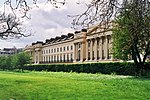221B Baker Street

221B Baker Street is the London address of the fictional detective Sherlock Holmes, created by author Sir Arthur Conan Doyle. In the United Kingdom, postal addresses with a number followed by a letter may indicate a separate address within a larger, often residential building. Baker Street in the late 19th century was a high-class residential district, and Holmes's apartment would probably have been part of a Georgian terrace. The residence was introduced in the novel A Study in Scarlet (1887). At the time the Holmes stories were published, addresses in Baker Street did not go as high as 221. Baker Street was later extended, and in 1932 the Abbey National Building Society moved into premises at 219–229 Baker Street. For many years, Abbey National employed a full-time secretary to answer mail addressed to Sherlock Holmes. In 1990, a blue plaque signifying 221B Baker Street was installed at the Sherlock Holmes Museum, situated elsewhere on the same block, and there followed a 15-year dispute between Abbey National and the Holmes Museum for the right to receive mail addressed to 221B Baker Street. Since the closure of Abbey House in 2005, ownership of the address by the Holmes Museum has not been challenged, despite its location between 237 and 241 Baker Street. Its postal code is NW1 6XE.
Excerpt from the Wikipedia article 221B Baker Street (License: CC BY-SA 3.0, Authors, Images).221B Baker Street
Baker Street, City of Westminster Marylebone
Geographical coordinates (GPS) Address Nearby Places Show on map
Geographical coordinates (GPS)
| Latitude | Longitude |
|---|---|
| N 51.523333333333 ° | E -0.15833333333333 ° |
Address
219 Baker Street
Baker Street 219
NW1 6XE City of Westminster, Marylebone
England, United Kingdom
Open on Google Maps











